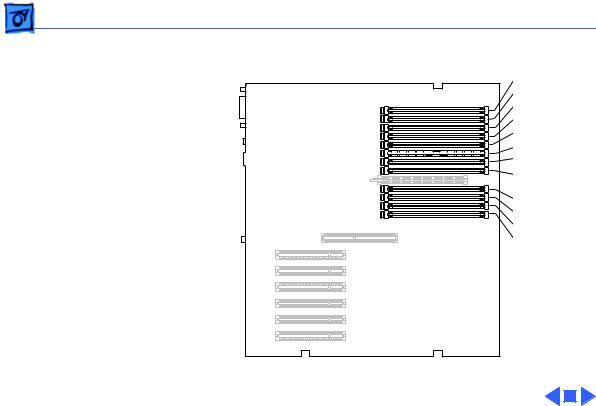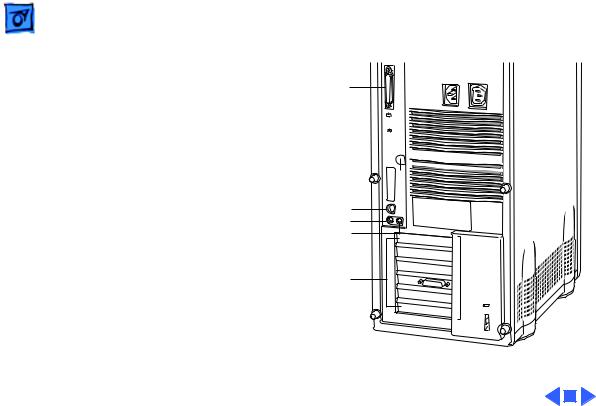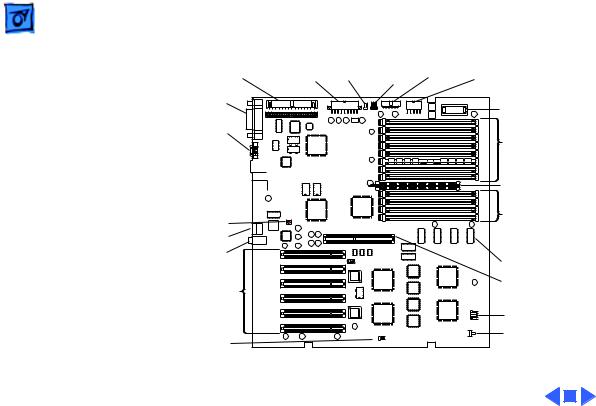Apple Macintosh Powermac Performa 9500 Service Manual

K Service Source
Power Macintosh 9500
Series
Power Macintosh 9500/120, 9500/132, 9500/150,
9500/180MP, and 9500/200

K Service Source
Basics
Power Macintosh 9500 Series

Basics |
Overview - 1 |
|
|
|
|
Overview
The Power Macintosh 9500 Series computers are based on the PowerPC 604 microprocessor and support the industry-standard PCI (Peripheral Component Interconnect) bus specification. These computers are the most flexible, expandable, and highest-performance systems from Apple to date.
The microprocessor for the Power Macintosh 9500 Series computers is on separate plug-in card, which allows for easy upgrades. The Power Macintosh 9500 family includes five versions: the 9500/120, the 9500/132, the 9500/150, the 9500/180MP (multi-processor), and the 9500/200.

Basics |
Overview - 2 |
|
|
|
|
Features of the Power Macintosh 9500 Series include
•120, 132, 150, 180 (multi-processor) or 200 MHz PowerPC 604 microprocessor card with built-in FPU
•Six PCI expansion slots
•10 MB per second internal SCSI channel, 5 MB per second external SCSI channel
•512K Level 2 cache
•DRAM expansion up to 1536 MB using 168-pin, 70 ns, 64-bit DIMMs
•A PCI Apple Accelerated Graphics card included with some configurations (the Power Macintosh 9500 Series does not include on-board video support)
•Built-in AAUI and 10BASE-T Ethernet
•AppleCD™ 600i 4x or1200i 8x CD-ROM drive
•CD-quality stereo sound in/out
•Mac™ OS system software 7.5.2, 7.5.3, or 7.5.3 Revision 2

 Basics Configurations - 3
Basics Configurations - 3
Configurations
The Power Macintosh 9500/120 comes standard with
•120 MHz PowerPC 604 processor card
•16 MB DRAM minimum
•1 GB hard drive
•AppleCD 600i CD-ROM drive
•Apple Accelerated Graphics card with 2 MB of VRAM
The Power Macintosh 9500/132 comes standard with
•132 MHz PowerPC 604 processor card
•16 MB DRAM minimum
•2 GB hard drive
•AppleCD 600i CD-ROM drive

Basics |
Configurations - 4 |
|
|
|
|
The Power Macintosh 9500/150 comes standard with
•150 MHz PowerPC 604 processor card
•16 or 32 MB DRAM minimum
•2 GB hard drive
•AppleCD 600i CD-ROM drive
The Power Macintosh 9500/180MP comes standard with
•180 MHz PowerPC 604e multi-processor card
•16 or 32 MB DRAM minimum
•2 GB hard drive
•AppleCD 1200i 8x-speed CD-ROM drive
The Power Macintosh 9500/200 comes standard with
•200 MHz PowerPC 604e processor card
•16 or 32 MB DRAM minimum
•2 GB hard drive
•AppleCD 1200i 8x-speed CD-ROM drive

Basics |
PowerPC 604 Microprocessor - 5 |
|
|
|
|
PowerPC 604 Microprocessor
The Power Macintosh 9500 Series computers feature the highest performance PowerPC processor available: the PowerPC 604 RISC microprocessor. Designed to bring unprecedented levels of performance to desktop computers, the Power PC 604 processor offers up to 1.5 times the performance of the PowerPC 601 processor at the same clock speed. Features include
•Full RISC processing architecture
•Parallel processing units: one load-store unit, two integer units, one complex integer unit, and one floating point unit
•Separate built-in caches for data and instructions, 16 KB each, four-way set associative
•Advanced branching techniques for improved throughput

Basics |
Multi-Processor Support - 6 |
|
|
|
|
|
The PowerPC 604 processor is installed via a processor |
|
|
card that plugs into the Macintosh 9500 Series logic board, |
|
|
allowing for maximum flexibility with future upgrades. |
|
Multi-Processor Support
The Power Macintosh 9500/180MP features two 180 MHz PowerPC 604e chips on its microprocessor card. This computer provides extremely rapid performance for applications that can take advantage of its coprocessing capabilities.

Basics |
Peripheral Component Interconnect (PCI) - 7 |
|
|
|
|
Peripheral Component Interconnect (PCI)
The Power Macintosh 9500 Series computers offer a Peripheral Component Interconnect (PCI) expansion bus. Because the PCI bus is an industry standard, most existing PCI 2.0-compliant cards (with the addition of a Mac OSspecific software driver) will work in the Power Macintosh 9500 Series computers.
PCI offers significantly higher performance than the NuBus architecture used in previous Macintosh models. Running at 33 MHz, the PCI bus is up to three times faster than NuBus, offering overall enhanced system performance, particularly in the areas of video and networking.

Basics |
Dual In-Line Memory Modules (DIMMs) - 8 |
|
|
|
|
Dual In-Line Memory Modules (DIMMs)
The Power Macintosh 9500 Series computers use DRAM Dual In-Line Memory Modules (DIMMs) instead of DRAM SIMMs.
Whereas SIMMs have 72 pins, DIMMs have 168 pins. The extra pins provide a 64-bit data path, compared to a 32-bit data path for SIMMs. In addition, DIMMs do not have to be installed in pairs like the SIMMs on earlier Macintosh models. (However, to take advantage of memory interleaving, the DIMMs should be installed in paired slots. See "Memory Configurations" in Basics for more information.)
Important: The Single In-Line Memory Modules (SIMMs) used in previous Macintosh models are NOT compatible with

Basics |
Dual In-Line Memory Modules (DIMMs) - 9 |
|||
|
|
|
||
|
the Power Macintosh 9500 Series computers. |
|||
|
Note: There is a double click seating process for installing |
|||
|
DRAM DIMMs. Be sure to push the DIMMs all the way into |
|||
|
the DIMM slots. |
|||
|
|
|
|
|
|
|
|
|
|

Basics |
Memory Configurations - 10 |
|
|
Memory Configurations
The Power Macintosh 9500 Series logic board has 12 DRAM DIMM slots, each with a 64-bit data bus. You can increase the computer’s DRAM to a total of 1536 MB using 5-volt, 64-bit-wide, 168-pin fast-paged mode, 70 ns DIMMs.
When installing DRAM DIMMs in the Power Macintosh 9500, fill slot A6 first, followed by B6, then A5, followed by B5, and so on. DRAM DIMMs can be installed individually; however, to take advantage of memory interleaving, which provides maximum performance, you must install the DIMMs in matching pairs and in paired slots (A6 and B6 first, then A5 and B5, and so on). DIMMs purchased from different manufacturers can be paired as long as they are the same size and speed.
Note: Memory interleaving allows the computer to read or

Basics |
Memory Configurations - 11 |
|
|
|
|
|
write to its memory while other memory reads or writes |
|
|
are occurring, thus providing for faster performance. |
|
|
The graphic on the following page illustrates the memory |
|
|
locations on the Power Macintosh 9500 logic board. |
|

Basics |
Memory Configurations - 12 |
|
B6 slot |
|
B5 slot |
|
B4 slot |
|
B3 slot |
|
B2 slot |
|
B1 slot |
|
A6 slot |
|
A5 slot |
|
A4 slot |
|
A3 slot |
|
A2 slot |
|
A1 slot |
|
(front of |
|
Computer) |
Figure: Power Macintosh 9500 Memory Locations

Basics |
Ethernet Support - 13 |
|
|
|
|
Ethernet Support
There are two Ethernet ports on the Power Macintosh 9500 Series logic board: an AAUI port and a 10BASE-T port. You can use only one Ethernet port at one time, however. If you have cables plugged into both Ethernet ports, the computer uses the 10BASE-T port by default.
PC Compatibility Cards
Apple computer offers two PC Compatibility Card upgrade kits that bring full DOS functionality to the Macintosh computer. Two versions of the PC Compatibility card are available: a 7" card and a 12" card. The cards plug into any available PCI slot on the logic board. Refer to the Upgrades chapter in this manual for installation instructions.

Basics |
GeoPort - 14 |
|
|
|
|
GeoPort
Geoport is a hardware and software communications architecture that has been optimized for computer-telephony integration. It has three main attributes:
•It lets any computer connect to any telephone (analog or digital, public or private) anywhere in the world.
•Once connected, it supports an arbitrary number of independent data streams up to a total bandwidth of 2 MB/ second.
•Unlike traditional asynchronous data communications (such as AppleTalk), GeoPort also supports isochronous data streams (such as real-time voice and video) and provides the real-time Application Program Interfaces (APIs) necessary to hide the implementation details from both the recipient and the sender.

Basics |
GeoPort - 15 |
|||
|
|
|
||
|
By attaching an Apple GeoPort Telecom Adapter to the Power |
|||
|
Macintosh 9500, you can enjoy all the features of a 14.4 |
|||
|
modem, including data, fax, send and receive, and voice |
|||
|
capabilities. The GeoPort Telecom Adapter serves as a line |
|||
|
interface to standard (analog) telephone lines. The adapter is |
|||
|
capable of sending or receiving data at up to 14.4 kbps and |
|||
|
faxes at up to 9600 bps using the GeoPort Telecom Adapter |
|||
|
software. |
|||
|
|
|
|
|
|
|
|
|
|

 Basics The Cuda Chip - 16
Basics The Cuda Chip - 16
The Cuda Chip
The Cuda is a microcontroller chip. Its function is to
•Turn system power on and off
•Manage system resets from various commands
•Maintain parameter RAM (PRAM)
•Manage the Apple Desktop Bus (ADB)
•Manage the real-time clock
Many system problems can be resolved by resetting the Cuda chip (see Symptom Charts for examples). Press the red Cuda reset button on the logic board to reset the Cuda chip. (See "Logic Board Diagram" later in this chapter to locate the Cuda reset button.) If you continue to experience system problems, refer to “Resetting the Logic Board” in this Basics chapter.

Basics |
Resetting the Logic Board - 17 |
|
|
|
|
Resetting the Logic Board
Resetting the logic board can resolve many system problems (refer to "Symptom Charts" for examples). Whenever you have a unit that fails to power up, you should follow this procedure before replacing any modules.
1Unplug the computer.
2Remove the logic board. (Refer to the Take Apart chapter for instructions on how to remove the logic board.)
3Using a small flat-blade screwdriver, pry open the latch at the end of the battery holder and lift off the battery holder cover.
4Remove the battery from its holder.

Basics |
Resetting the Logic Board - 18 |
|||
|
|
|
||
|
5 Verify the power supply cable is disconnected from the |
|||
|
logic board and then press the Power On button. (See |
|||
|
"Logic Board Diagram" later in this chapter to locate the |
|||
|
Power On button.) |
|||
|
6 Wait at least 10 minutes before replacing the battery. |
|||
|
Make sure the battery is installed in the correct +/- |
|||
|
direction. |
|||
|
7 Reassemble the computer and test the unit. |
|||
|
Note: This procedure resets the computer’s PRAM. Be sure |
|||
|
to check the computer’s time/date and other system |
|||
|
parameter settings afterwards. |
|||
|
Note: If this procedure resolves the problem, claim an |
|||
|
adjustment on an SRO. If not, replace the defective |
|||
|
component and DO NOT claim the adjustment procedure. |
|||
|
|
|
|
|
|
|
|
|
|

Basics |
Fast SCSI - 19 |
|
|
|
|
Fast SCSI
The Power Macintosh 9500 Series computers offer Fast SCSI support on the internal SCSI connector, which provides for significantly enhanced data throughput. The internal SCSI bus on these computers supports transfer rates up to 10 MB/sec.

Basics |
Rear View Diagram - 20 |
|
|
|
|
Rear View Diagram
The Power Macintosh 9500 Series computers offer the following external ports: SCSI, AAUI Ethernet, 10BASE-T Ethernet, serial printer (GeoPort compatible), serial modem (GeoPort compatible), ADB, sound input, and sound output.
Some configurations of the Power Macintosh 9500 also includes a DB-15 video port on the Apple Accelerated Graphics card, which installs in one of the PCI slots on the logic board.
The drawing on the next page illustrates the rear panel on the Power Macintosh 9500 Series computers.

Basics |
Rear View Diagram - 21 |
|
|
|
|
SCSI
AAUI Ethernet  10BASE-T Ethernet
10BASE-T Ethernet 

Printer 


 Modem
Modem 

ADB |
Sound In |
Sound Out |
PCI Slots |
Figure: Power Macintosh 9500 Rear Panel

Basics |
Logic Board Diagram - 22 |
|
|
|
|
Logic Board Diagram
The graphic on the following page illustrates the connectors on the Power Macintosh 9500 Series logic board.
Note: The board ships with 4 MB of ROM, which may either be soldered or installed as a ROM SIMM.

Basics |
Logic Board Diagram - 23 |
|
|
|
|
Internal SCSI
External
SCSI
AAUI
Ethernet
10BASE-T 


Ethernet
Printer/ 
Modem
Cuda Reset
ADB
Sound
In/Out
PCI
Slots
Fan
Power
Supply
Speaker |
CD-ROM |
Floppy |
Audio |
Drive Power Supply |
|
|
|
Battery |
|
|
DRAM |
|
|
DIMM |
|
|
Slots |
|
|
ROM |
|
|
SIMM |
|
|
DRAM |
|
|
DIMM |
|
|
Slots |
|
|
ROM (4 MB) |
|
|
Processor |
|
|
Card Slot |
|
|
Power LED |
|
|
Power On/Off |
Power Macintosh 9500 Logic Board

K Service Source
Specifications
Power Macintosh 9500 Series

Specifications |
Processor - 1 |
|
|
|
|
Processor
9500/120
9500/132
9500/150
PowerPC 604 RISC microprocessor running at 120 MHz Built-in FPU
Requires system software version 7.5.2 or later with System Enabler version 701
PowerPC 604 RISC microprocessor running at 132 MHz Built-in FPU
Requires system software version 7.5.2 or later with System Enabler version 701
PowerPC 604 RISC microprocessor running at 150 MHz Built-in FPU
Requires system software version 7.5.3 or later with appropriate System Enabler

|
Specifications |
Processor - 2 |
|||
|
|
|
|
||
9500/180MP |
Two PowerPC 604e RISC microprocessors each running at |
||||
|
|
180 MHz |
|||
|
|
Built-in FPU |
|||
|
|
Requires system software 7.5.3 Revision 2 or later |
|||
9500/200 |
PowerPC 604e RISC microprocessor running at 200 MHz |
||||
|
|
Built-in FPU |
|||
|
|
Requires system software 7.5.3 Revision 2 or later |
|||
|
|
|
|
|
|
|
|
|
|
|
|

Specifications |
Memory - 3 |
|
|
|
|
DRAM
ROM
Cache
Clock/Calendar
Memory
16 or 32 MB standard; expandable to 1536 MB
Uses 168-pin, 64-bit, 70 ns or faster DRAM DIMMs
4 MB ROM (may be installed in ROM SIMM slot, or soldered on the logic board)
512K Level 2 cache soldered on the logic board CMOS custom circuitry with long-life battery

Specifications |
I/O Interfaces - 4 |
|
|
|
|
SCSI
Serial
ADB
Ethernet
I/O Interfaces
Dual-channel asynchronous SCSI interface; external channel supports up to seven SCSI devices; internal channel supports a hard disk array
Two RS-232/RS-422 serial ports compatible with LocalTalk and GeoPort cables; mini DIN-8 connectors
One Apple Desktop Bus port for a keyboard, mouse, etc.
One AAUI and one 10BASE-T Ethernet port (if cables are plugged into both ports, system defaults to 10BASE-T)
